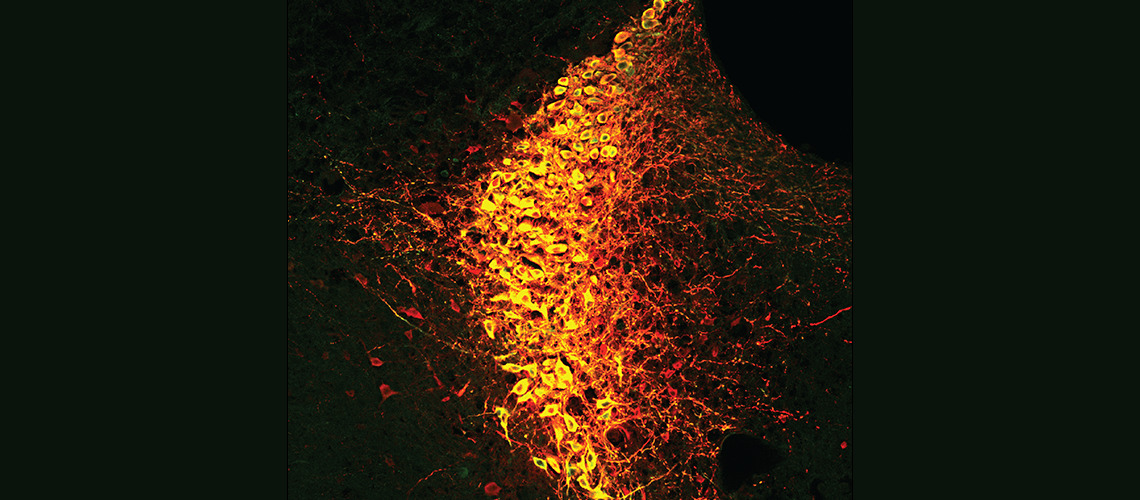A team from UNIGE and ETH Zurich has shown how the locus coeruleus, a small region of the brain, manages the transition from intense focus to heightened global awareness.

What enables our brain to go from intense concentration to a heightened state of alertness? A study carried out by neuroscientists at the University of Geneva (UNIGE), in collaboration with ETH Zurich, shows that a brain region called locus coeruleus (LC) and the neurotransmitter noradrenaline act as conductors, reorganising brain functions according to the mental demands of the moment. The study, to discover in Nature Neuroscience, demonstrates that the way the locus coeruleus is triggered enables us to switch from one state of concentration to another. This discovery could change the way elite sportsmen and women train to achieve their goals.
How do athletes achieve the extraordinary mental clarity and precision needed to succeed in their discipline? The answer lies in the brain's remarkable ability to focus, eliminating distractions to concentrate on a single task. This phenomenon, often described as 'being in the zone', is a critical skill not just for athletes, but for anyone facing a challenging task—whether it's taking an exam or mastering a musical instrument. At times, however, these people also need to be fully aware of their environment, especially when it comes to spotting potential dangers.
A handful of neurons
In this study, neuroscientists from UNIGE and ETH investigated what allows the brain to shift between intense focus and heightened awareness. The research team focused on the locus coeruleus (LC), a small region in the brainstem that produces noradrenaline, a neurotransmitter involved in regulating arousal. "It's small and its location deep within the brain was a challenge from the outset, making it difficult to observe – and impossible to manipulate - in humans. For these reasons, we turned to mice where the LC consists of only about 3,000 neurons, but these neurons can still exert a significant influence over the 75 million neurons that make up the mouse brain,» explains Valerio Zerbi, assistant professor in the Department of Psychiatry and the Department of Basic Neurosciences at the UNIGE Faculty of Medicine, and initiator of the study.
To overcome this challenge, his team collaborated with Johannes Bohacek's laboratory at ETH Zurich. Using advanced techniques such as optogenetics to artificially manipulate LC neurons and photometry to measure noradrenaline release, the researchers were able to explore LC function. Functional Magnetic Resonance Imaging (fMRI) provided first empirical evidence into how LC stimulation affects brain activity across different regions, shedding light on the LC's role in dynamically modulating attention and focus.
A question of rhythm
Neuroscientists discovered that triggering the LC three times a second in a continuous manner - so-called "tonic" activity - had different consequences to triggering the same frequency over a short period of time - so-called "burst" activity. "When the LC is triggered in bursts, more noradrenaline is released, and the brain's sensory functions are prioritised. This sensory brain mode enables mice to be more alert to the environment around them," explains Valerio Zerbi.
Conversely, when the LC is triggered in a moderate tonic mode, less noradrenaline is released by the LC and brain regions such as the prefrontal cortex and hippocampus are activated. These two structures are known for processing information and are conducive to reflection and intense attention.
Controlling the locus coeruleus for performance
''While cutting-edge equipment and meticulous training are certainly part of the equation, the secret of top athletes may well lie in their mastery over their LC. By finely tuning its activity, they can switch between states of intense focus and broad awareness, performing at their peak when it matters most,'' concludes Valerio Zerbi.
Also, thanks to the findings of this study, brain imaging could help sportsmen and women to make better use of their LC, notably by using neurofeedback approaches, a technique that uses devices to monitor brain activity in real time to enable a person to regulate it based on visual feedback.






